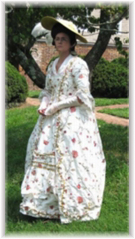
You could start with wool from the right type of sheep, (or the right flax),
Spin & dye using the correct methods, dyes & mordants, weave using
the right loom, weave, thread count and pattern, cut using the right snips
or shears. Make up using the right patterns, linings, stitches and thread,
right types of fastenings, braids, notions. Used all the research available.
But how authentic is it?
Let's presume for a second that you are copying an extant garment.
Has the colour faded? Who wore it? What for? Was it for every day wear or something special? Has it been adapted to change it's size or style since first being made?
All valid questions. I am sure that you'll agree.
And what do you call your copy?
Facsimile, reproduction, replica or reconstruction? The picture on the left, (Based on the Wedding dress of Elizabeth Bowes Lyon) has only 17,000 pearls & glass beads instead of the originals 24,000+ , so we don't call it a copy. We say 'Based on'.
And if the size being made is different from the original, it's not
really a copy anymore - is it?
Most people ordering garments from a tailor are not going to go the
'authentic as possible' route, unless it's for Museum or educational study.
It really is an expensive way to go.But when does compromise go too far? The answer really, is in your court.We will make what you ask for, but fancy dress and 'McHalfords' Tartan car rugs worn by 18th C ' highlanders' is somewhere we won't go.
It's a good idea to do a little research yourself - and be careful of popular
myth.
As a friend of ours says,
There is more evidence of pirates with cross bows,
than pirates in 'Bucket top' boots!




1 comment:
The same discussion has been happening over at the Soper Lane website with regards to narrow wares. It is interesting to see that terminology is a 'problem' in other disciplines too.
I also tend to use 'based on', although an interesting suggestion was 'interpretation'.
Gina
Post a Comment